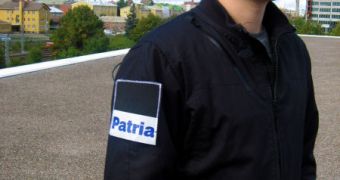Finland-based Patria Aviation Oy is currently one of the few companies in the world seeking to create personal satellite-communication antennas out of textile materials. Its instrument is roughly similar to the one members of Enterprise used in the Star Trek series. A simple touch of a badge was enough to open a communication channel with anyone. Similar performances could become a reality much faster than we think, if the research conducted at Patria becomes a reality, and wearable, textile materials will, indeed, be able to communicate with satellites, SpaceFellowship reports.
“Flexible antennas are becoming attractive, since the recent developments in ‘wearable computing’ have opened several possibilities to integrate wireless functions into clothing,” Rolv Midthassel explains. He represents the interests of the European Space Agency (ESA) in this project. ESA is involved with supporting this line of research, as any results could be applied successfully on the International Space Station, for example, or during future, long flights to other planets or the Moon.
Patria is involved in all stages of creating the new clothes, from selecting and establishing the traits of materials that will make it up to creating and verifying the final design. The demonstrator antenna that was obtained following these studies looks like an arm patch, and it can be worn on the sleeve of any jacket or T-shirt. It can also operate in the Iridium and GPS frequency band. “The use of GPS and the Iridium satellite phone system for this project may be an attractive combination for a later product. The Iridium satellites allow two-way voice and data communication, while GPS provides positional data to the user. Iridium could also relay the position of the user to operational centers,” Midthassel adds.
Creating the patch raised numerous problems, such as whether it could be ironed on, or whether it could withstand washing or not. Temperature ranges were also a problem in the early stages of development. Representatives from Patria said that the directions, support and feedback they got from ESA were invaluable for the successful completion of the antenna. The device was already used to place a call from the company's headquarters, in Finland, to ESTEC, in Noordwijk, the Netherlands.
“We have been pushed to go further to reach the goal of what we promised to do. Comments and suggestions from ESA staff during the project have been valuable, giving us new insight into all the variables we should take into account, apart from the engineering factors. The results are a good example of close cooperation between the customer and contractor,” Patria Aviation Oy Research and Development Manager Dr. Pekka Salonen concludes.

 14 DAY TRIAL //
14 DAY TRIAL //